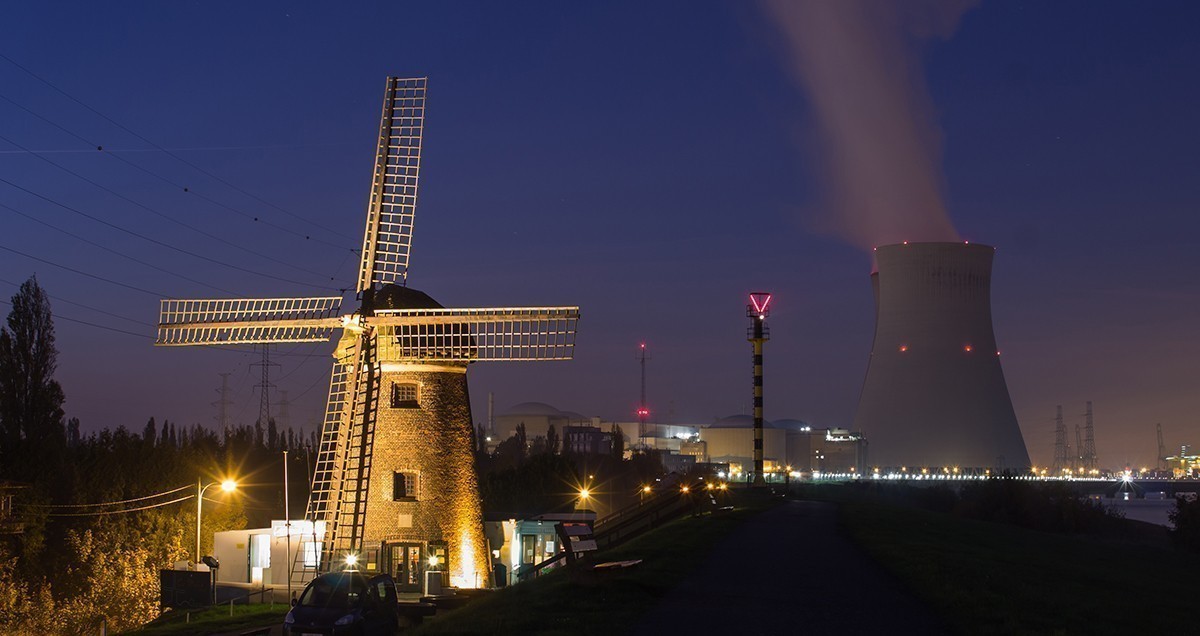
Nuclear Facility Doel Belgium, 2015 © Bas Meijer
By Elke Weesjes
Even while Belgium is reeling from terrorist bombings of Zaventem Airport and Maalbeek metro station in Brussels, there is reason to believe that terrorists might have considered infiltrating or sabotaging a nuclear facility to obtain nuclear or radioactive material.
Belgian nuclear facilities have been on high alert after a November raid on Islamic State terror cells turned up a video of terrorist surveillance of a senior nuclear official. Last week, however, intelligence linked three men suspected in either the Brussels or 2015 Paris attacks to the video, according to the New York Times.
The revelation gave new urgency to security efforts and spurred even tighter security at the country’s seven reactors located in eastern Flanders, where some workers were stripped of their access badges, non-essential staff were sent home, and military presence was increased.
While the purpose of the surveillance footage—a 10-hour video that recorded the official leaving and entering his home near the SCK-CEN facility where he worked—wasn’t clear, some experts speculated that ISIS might have plotted kidnapping the official to obtain the necessary material to create a so-called dirty bomb, a conventional explosive with radiological material strapped on to it.
Others, however rejected that scenario. Harvard Professor Matthew Bunn, for example, argued it was unlikely terrorists would go to the trouble since radiological materials are also available in lower security locations such as hospitals and industrial sites. Instead, Bunn, the lead author of a new report on preventing nuclear terrorism, thinks that SCK-CEN's highly enriched uranium (HEU)—used to build to nuclear bombs—might have been the terrorists’ ultimate objective.
“Unfortunately, as we document in detail in our recent report, repeated government studies, in the United States and elsewhere, have concluded […] that it is quite plausible that a sophisticated terrorist group could make a nuclear bomb if they got the needed nuclear material,” Bunn wrote in The Huffington Post
Regardless of the reason behind the video, its potential import reverberated through the nuclear industry—and not just in Belgium, which has been scrutinized for past security lapses at nuclear facilities and generally weak intelligence operations.
It might be tempting to believe that other nuclear facilities worldwide are better protected, but problem is much wider spread, Yukiya Amano, director general of the International Atomic Energy Agency, told Agence France Presse. Many other countries are just as vulnerable and not doing enough to prevent nuclear terrorism.
“Terrorism is spreading and the possibility of using nuclear material cannot be excluded,” Amano said. “Member states need to have sustained interest in strengthening nuclear security. The countries which do not recognize the danger of nuclear terrorism is [sic] the biggest problem.”
One such example can be seen in the Iraq theft of radioactive material last November.
In 2010, President Obama created the Nuclear Security Summit to address these issues surrounding securing nuclear materials. The bi-annual initiative is attended by about 55 nations and international organizations and encourages governments to eliminate weapons-usable nuclear materials and improve nuclear security culture.
This Thursday, the fourth and final meeting will take place in Washington D.C.
Leaders plan to discuss ways to reduce the use of HEU and to combat nuclear smuggling. In addition, President Obama will convene a special session focused on ISIS, bolstering security in urban centers, and preventing ISIS from obtaining nuclear material.
Since 2009, large quantities of HEU and plutonium (176.6 metric tons—enough for almost 7000 nuclear weapons) have been removed or downblended through U.S. actions in cooperation with international partners. However, some 2,000 metric tons of material is currently still present in civilian and nuclear programs around the world.
According to Bunn, more action is warranted in order to secure this material and protect major nuclear facilities from sabotage. Radiological sources must be “protected, tracked throughout their life and, where possible, replaced with less dangerous technologies,” he wrote.
“The world needs to act to ensure that ISIS can never get its hands on the ingredients of nuclear terror.”
Elke Weesjes Sabella is former editor of the Natural Hazards Observer. She joined the staff in December 2014 after a brief stint as a correspondent for a United Nations nonprofit. Under her leadership, the Observer was revamped to a more visual format and one that included national and international perspectives on threats facing the world. Weesjes was the editor of the peer-reviewed bimonthly publication United Academics Journal of Social Sciences from 2010 to 2013.
Weesjes Sabella also worked as a research associate for the Center for Disaster and Risk Analysis, formerly located at Colorado State University (although no longer active). In that role, she collected and analyzed data and translated research findings for a broader audience. She played a central role in finalizing the Disaster Preparedness among Childcare Providers in Colorado project, which examines all-hazards preparedness in daycares and in-home childcare across Colorado. She co-authored the report based on the first stage of the project, which was funded by Region VIII of the Federal Emergency Management Agency.
Weesjes Sabella specializes in cultural memory and neighborhood/community change in times of acute and chronic stress. She has published articles on the impact of drought on farming communities in Kansas, the effects of Superstorm Sandy in Far Rockaway, Queens, urban renewal in the Bedford-Stuyvesant neighborhood in Brooklyn, and health services for vulnerable populations in the South Bronx.
Weesjes Sabella received her PhD from the University of Sussex. Her dissertation, Children of the Red Flag: Growing up in a Communist Family During the Cold War (2012), as well as the majority of her publication record, share the common methodology of understanding culture and identity through oral history.